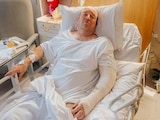A team from the NSG's Bomb Data Centre - which collects, collates and evaluates all terrorist-related bombings in India and abroad - will analyse fragments of the IED (improvised explosive device) that was detonated outside the Israeli embassy in central Delhi on Friday evening.
The NSG team visited the blast site today to collect these fragments. Forensics teams had earlier found evidence that ammonium nitrate was used in the IED; this appears to rule out the presence of RDX, sources said, explaining that the blast impact would have been larger in that case.
This morning Delhi Police sources said the blast could be a "trial run" - a prelude to a larger attack - and part of a "big conspiracy" to send a message from Iran to Israel. Several possible leads, including a letter to Ron Malka, the Israeli ambassador, have been identified.
Ahead of the attack, the Israeli government issued a directive for increased vigilance at its embassies around the world - due to fears of an Iranian attack - news agency ANI reported.
The letter, found 12 metres from the blast site, mentions the word "trailer" and Qasem Soleimani (a top Iranian military commander) and Mohsen Fakhrizadeh (an Iranian nuclear scientist).
Both Soleimani and Fakhrizadeh were killed last year; the former in a January drone strike ordered by former US President Donald Trump, and the latter in November in an attack on his car.
Following recovery of the letter and reports that Israel suspects the hand of Iran's Islamic Revolutionary Guard in this attack, Delhi Police has asked the Foreigners Regional Registration Office (FRRO) to provide details of Iranian visitors to the national capital in the last few weeks.
Delhi Police's Special Cell and several other agencies are working together to investigate the blast
The police and other agencies investigating the blast are also searching places in the city where suspects may be hiding, sources said, adding officials from Israeli agencies were en route to assist.
Apart from the IED fragments and the letter, authorities are also scouring CCTV footage from surrounding areas. However, collating and analysing this footage could be a challenge because some of the cameras, including one on a tree near the blast site, were malfunctioning.
One video, however, revealed a cab driver near the site. Delhi Police's Special Cell tracked him down and found he was only heading to the airport to drop a passenger.
The actual blast took place outside a residence near the embassy, but there were no CCTV cameras installed at that point.
A half-burnt pink-coloured scarf was also recovered from the blast site.
A "very low-intensity" IED (improvised explosive device) was detonated near the the Israeli embassy at 5.05 pm on Friday. No injuries or major property damage was reported.
The blast took place 1.4 kilometres from Vijay Chowk, where President Ram Nath Kovind, Prime Minister Narendra Modi and other senior members of the government had gathered, amid extremely heavy security, for the Beating Retreat ceremony that follows the Republic Day parade.
Israel Prime Minister Benjamin Netanyahu has expressed "full confidence" that India will fully investigate the blast, and "ensure the safety of Israelis and Jews who are there".
This is the second blast to take place involving the Israel embassy; the first was in February 2012, when a bike-borne attacker planted a 'sticky bomb' on an embassy vehicle at a traffic junction.
The explosion took place just 300 metres from the Prime Minister's residence. Four people, including the wife of an Israeli diplomat, were injured.
With input from ANI















